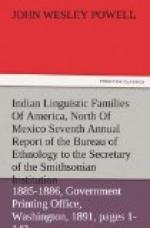= Chu-cha-chas, Keane, App. Stanford’s
Comp. (Cent. and So. Am.), 479,
1878 (misprint; follows Lane).
= Kes-whaw-hay, Lane in Schoolcraft, Ind.
Tribes, V, 689, 1855 (same
as Chu-cha-cas above). Keane, App.
Stanford’s Comp. (Cent. and So.
Am.), 479, 1878 (follows Lane).
Derivation unknown. The name is pronounced with an explosive initial sound, and Ad. F. Bandelier spells it Qq’ueres, Quera, Queris.
Under this name Turner, as above quoted, includes the vocabularies of Kiwomi, Cochitemi, and Acoma.
The full list of pueblos of Keresan stock is given below. They are situated in New Mexico on the upper Rio Grande, on several of its small western affluents, and on the Jemez and San Jose, which also are tributaries of the Rio Grande.
VILLAGES.
Acomita.[57]
Cochiti.
Hasatch.
Laguna.
Paguate.
Pueblito.[57]
Punyeestye.
Punyekia.
Pusityitcho.
San Felipe.
Santa Ana.
Santo Domingo.
Seemunah.
Sia.
Wapuchuseamma.
Ziamma.
[Footnote 57: Summer pueblos only.]
Population.—According to the census of 1890 the total population of the villages of the family is 3,560, distributed as follows:
Acoma[58] 566 Cochiti 268 Laguna[59] 1,143 Santa Ana 253 San Felipe 554 Santo Domingo 670 Sia 106
[Footnote 58: Includes Acomita and Pueblito.]
[Footnote 59: Includes
Hasatch, Paguate, Punyeestye, Punyekia,
Pusityitcho, Seemunah, Wapuchuseamma,
and Ziamma.]
KIOWAN FAMILY.
= Kiaways, Gallatin in Schoolcraft, Ind.
Tribes, III, 402, 1853 (on
upper waters Arkansas).
= Kioway, Turner in Pac. R. R. Rep., III, pt. 3, 55, 80, 1856 (based on the (Caigua) tribe only). Buschmann, Spuren der aztek. Sprache, 432, 433, 1859. Latham, EL. Comp. Phil., 444, 1862 ("more Paduca than aught else").
= Kayowe, Gatschet in Am. Antiq.,
280, Oct., 1882 (gives phonetics
of).
Derivation: From the Kiowa word Ko-i, plural Ko-igu, meaning “Kayowe man.” The Comanche term kayowe means “rat.”
The author who first formally separated this family appears to have been Turner. Gallatin mentions the tribe and remarks that owing to the loss of Dr. Say’s vocabularies “we only know that both the Kiowas and Kaskaias languages were harsh, guttural, and extremely difficult."[60] Turner, upon the strength of a vocabulary furnished by Lieut. Whipple, dissents from the opinion expressed by Pike and others to the effect that the language is of the same stock as the Comanche, and, while admitting that its relationship to Camanche is greater than to any other family, thinks that the likeness is merely the result of long intercommunication. His opinion that it is entirely distinct from any other language has been indorsed by Buschmann and other authorities. The family is represented by the Kiowa tribe.




